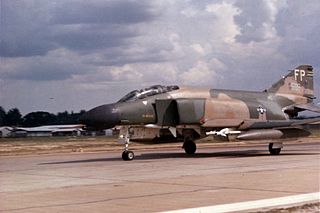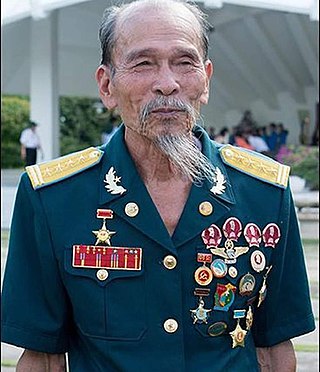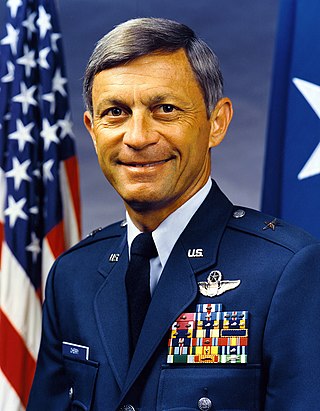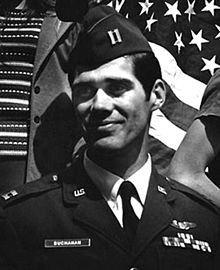
The Mikoyan-Gurevich MiG-17 is a high-subsonic fighter aircraft produced in the Soviet Union from 1952 and was operated by air forces internationally. The MiG-17 was license-built in China as the Shenyang J-5 and Poland as the PZL-Mielec Lim-6. The MiG-17 is still being used by the North Korean air force in the present day and has seen combat in the Middle East and Asia.

Operation Rolling Thunder was a gradual and sustained aerial bombardment campaign conducted by the United States (U.S.) 2nd Air Division, U.S. Navy, and Republic of Vietnam Air Force (RVNAF) against North Vietnam, China and North Korea from 2 March 1965 until 2 November 1968, during the Vietnam War.

Operation Linebacker II, sometimes referred to as the Christmas bombings and, in Vietnam, Dien Bien Phu in the air, was a strategic bombing campaign conducted by the United States against targets in North Vietnam from 18 December to 29 December 1972, during the Vietnam War. More than 20,000 tons of ordnance was dropped on military and industrial areas in Hanoi and Haiphong and at least 1,624 civilians were killed. The operation was the final major military operation carried out by the U.S. during the conflict, and the largest bombing campaign involving heavy bombers since World War II.

Operation Linebacker was the codename of a U.S. Seventh Air Force and U.S. Navy Task Force 77 air interdiction campaign conducted against North Vietnam from 9 May to 23 October 1972, during the Vietnam War.

Brigadier General James Robinson "Robbie" Risner was a fighter pilot in the United States Air Force, and a senior leader among U.S. prisoners of war during the Vietnam War.

Colonel Tomb, also Nguyen Toon or Colonel Toon was a mythical North Vietnam Air Force fighter ace loosely based on a North Vietnamese pilot from the 921st Fighter Regiment named Nguyen Van Coc. Tomb allegedly shot down 13 American aircraft during the Vietnam War. According to legend, he was killed in action on May 10, 1972, by the U.S. Navy F-4 Phantom crew of pilot Lt. Randy "Duke" Cunningham and radar operator Lt.(jg) William "Irish" Driscoll. It was later revealed by historians that there had been no such colonel in the North Vietnam forces.

Brigadier General Richard Stephen Ritchie served as an officer in the United States Air Force and the Colorado Air National Guard, and a general officer in the Air Force Reserve. Ritchie joined Navy Commander Randy Cunningham as the only two pilots among the five American aces during the Vietnam War. Ritchie is a recipient of the Air Force Cross, the second highest military decoration that can be awarded to a member of the United States Air Force.
Nguyễn Văn Cốc is a former North Vietnamese MiG-21 fighter ace of the Vietnamese People's Air Force's 921st Fighter Regiment.
Ubon Royal Thai Air Force Base is a Royal Thai Air Force (RTAF) facility located near the city of Ubon Ratchathani, in Ubon Ratchathani Province. It is approximately 488 km northeast of Bangkok. The Laos border is about 60 kilometres (37 mi) directly east. The facility is also used as a civil airport.

Operation Bolo was a United States Air Force mission during the Vietnam War, considered to be a successful combat ruse.
The Thanh Hóa Bridge, spanning the Song Ma river, is situated 3 miles (4.8 km) northeast of Thanh Hóa, the capital of Thanh Hóa Province in Vietnam. The Vietnamese gave it the nickname Hàm Rồng. In 1965 during the Vietnam War, it was the objective of many attacks by US Air Force and US Navy aircraft which would fail to destroy the bridge until 1972, even after hundreds of attacks. The bridge was restored in 1973. As of 2016, the bridge still stands.

Nguyễn Văn Bảy, was a Vietnamese jet fighter ace for the Vietnam People's Air Force during the Vietnam War. Piloting a MiG-17F while assigned to the 923rd Fighter Regiment, Bay claimed 7 aerial combat victories while engaged against aircraft of the USAF and USN: 2 F-8s, 1 F-4B, 1 A-4C and 1 F-105D. Of the 7 claimed victories, 5 are acknowledged by American documents. Of 16 VPAF aces during Vietnam War, only Bay, Luu Huy Chao, and Le Hai solely flew MiG-17s.
Lê Thanh Đạo was a MiG-21 pilot of the Vietnamese People's Air Force. He flew with the 921st and 927th fighter regiment and tied for fourth place amongst Vietnam War fighter aces with six kills.
"We took off from Noi Bai Airbase ascending to an altitude of 3,500m toward Ba Vi... we discovered the enemy Phantoms and intercepted two aircraft in a pair, and I prepared to launch my missile, when another F-4 hit my MiG-21 and I had to eject immediately. While I was descending, a Phantom fired a burst from their cannon which made many holes in my parachute... I had fallen and crashed into a big rock at high speed. I was unconscious for two days; both legs and vertebra were broken... locals made a stretcher from my parachute and transported me a distance of 9km where an Mi-6 helicopter brought me to Hospital No. 108 where I stayed for 4 months... I was only able to return to flight duty after a year."
The Vietnam People's Air Force Museum, Hanoi or Bảo Tàng Phòng Không - Không Quân is located on Truong Chinh Street in the Bach Mai District of Hanoi. The museum is on the edge of the disused Bach Mai Airfield.

The Vietnam People's Air Force, officially the Air Defence - Air Force Service or the Vietnam Air Force, is the aerial and air defence service branch of Vietnam. It is the modern incarnation of the so-called North Vietnamese Air Force (NVAF) and absorbed the South Vietnamese Air Force (RVNAF/VNAF) following the reunification of Vietnam in 1975 and is one of three main branches of the People's Army of Vietnam, which is under the executive administration of the Ministry of National Defence. The main mission of the VPAF is the defence of Vietnamese aerospace and the provision of air and space cover for operations of the People's Army of Vietnam.

Roger Clinton Locher is a retired Colonel in the U.S. Air Force and a former McDonnell Douglas F-4D Phantom II Navigator/Weapon Systems Officer (WSO) and subsequent Pilot who, during Operation Linebacker in the Vietnam War, was shot down only 40 miles (64 km) from Hanoi, North Vietnam. The 23 days Locher spent behind enemy lines evading capture was a record for downed airmen during the war. USAF General John W. Vogt, Jr., commanding general of the Seventh Air Force, "shut down the war" and sent 119 aircraft to recover him. His rescue was the deepest inside North Vietnam during the entire War.
The action of 23 August 1967 was a major air battle which involved elements of the Vietnam People's Air Force (VPAF) and the United States Air Force (USAF). The air battle took place over the skies of North Vietnam as part of Operation Rolling Thunder, during the Vietnam War.

Phúc Yên Air Base is a Vietnam People's Air Force (VPAF) (Không quân Nhân dân Việt Nam) military airfield located immediately north of Noi Bai International Airport and approximately 30 km north of Hanoi.
Richard Paul Keirn was a colonel and fighter pilot in the United States Air Force. He was one of two United States service members to be a prisoner of war (POW) in both World War II and the Vietnam War and was the first US airman to be shot down by a surface-to-air missile (SAM) during the Vietnam War.

Edward Daniel Cherry is an American retired military officer who served as a brigadier general and a career fighter pilot in the United States Air Force. Cherry flew a combined total of 285 combat missions in F-105 Thunderchiefs and F-4 Phantoms during the Vietnam War, and was credited with destroying 1 enemy aircraft in aerial combat.














